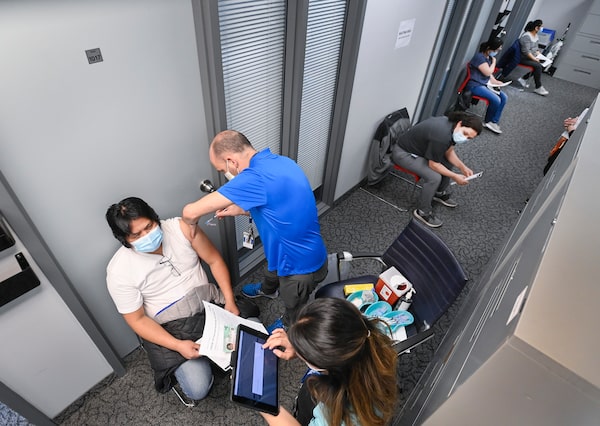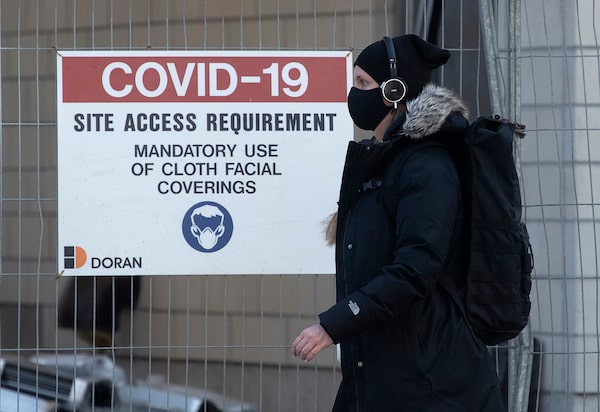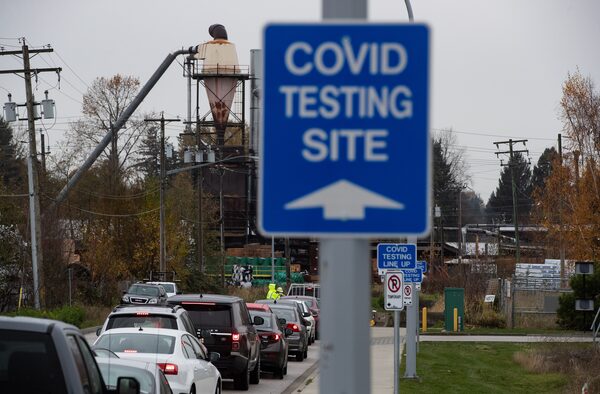
Front-line workers at a pharmaceutical company are given COVID-19 shots at a mobile clinic set up by Humber River Hospital on April 9, a week when the province stepped up measures to vaccinate workplaces and high-risk postal codes.Nathan Denette/The Canadian Press
After being infected with COVID-19 while working at a long-term care home in Toronto last May and quarantining for 14 days, Manu Verma wasn’t feeling well enough to return to her job. She was still suffering from chest congestion, extreme fatigue and diarrhea, and she had inadvertently passed the virus on to her husband, who would spend months in the hospital in a coma as a result.
Despite her lingering symptoms, Ontario’s workers compensation board rejected the 68-year-old’s request for an extension on her claim for lost time at work since her most recent test had come back negative. Stunned, she asked the Workplace Safety and Insurance Board to reconsider its decision and submitted a form from her doctor stating that she was not yet fit to perform the responsibilities of her job.
While she waited for a response, she applied for the federal government’s caregiver benefit since she was helping her husband recover, which paid $450 per week after taxes for up to 15 weeks.
In July, the WSIB rejected Ms. Verma’s objection. The doctor’s document did not “contain any objective medical evidence to support” that she was still impaired due her COVID-19 infection, the board said in a letter to Ms. Verma.
“I went to the emergency room twice, my blood pressure dropped, and my doctor told me not to drive a car, and that this is all tied to COVID,” Ms. Verma said. “I couldn’t go back to work, but the WSIB told me that after 14 days I had tested negative and I was supposed to be at work. But how can I help people at the long-term care home if I’m not well?”
Workers compensation programs across Canada have rejected about 12,000 of the more than 60,600 COVID-19-related claims they’ve received over the past year, leaving workers like Ms. Verma fighting for lost wages and in some cases, turning to taxpayer-funded programs such as the federal government’s Canada Emergency Response Benefit and personal healthcare plans with private insurers.
For workers who’ve seen their claims rejected, options like these offer less financial security because they don’t pay as much, but labour union representatives say they’re troubling for another reason: They transfer the cost of compensation for work-related illness away from employers. And the representatives suggest that some workplaces aren’t properly reporting COVID-19 incidents, which can make it even harder for employees to make successful claims.
“These workers aren’t in a position to miss out on weeks of pay,” said Keri Grainger, the WCB and disability advisor at UFCW Local 401 in Alberta.
“A lot of the money paid to workers for COVID came from the incorrect source. The burden is falling on the taxpayer, not the employer who is responsible.”
Provincial and territorial workers compensation boards are supposed to provide pay and benefits to employees when they are injured or fall ill on the job. Most employers are required to pay into regional workers compensation programs to cover workers, but who qualifies, what’s covered, whether a claim will be accepted, and the information made public depends on the province, agency and employer.
More than 90 per cent of workers in British Columbia, Newfoundland and Labrador, Prince Edward Island, Quebec and New Brunswick have access to workers compensation, but rates are lower in other provinces. Coverage in Ontario, Manitoba, Saskatchewan, Alberta and Nova Scotia ranges from 73 per cent to 82 per cent, according to 2019 data from the Association of Workers’ Compensation Boards of Canada.
Ontario’s WSIB received more than 20,100 claims related to COVID-19 as of March 5, of which 90 per cent were approved. Health services and long-term care accounted for 58 per cent of all claims, and agriculture, food processing, manufacturing and retail workers filed one-quarter of all claims.
But considering that workplaces accounted for as much as one-third of all outbreaks during the second wave in Ontario, the number of claims and exposure reports submitted to the WSIB should be much higher, according to David Chezzi, national representative Canadian Union of Public Employees (CUPE).
Nearly 1,900 outbreaks have occurred at workplaces in Ontario since March 2020, according to data from Public Health Ontario. Those incidents range in size from two employees per workplace to hundreds, including recent large-scale outbreaks at a Canada Post facility and an Amazon warehouse in the Peel Region west of Toronto.

A pedestrian walks past COVID-19 safety signs at an Ottawa construction site.Adrian Wyld/The Canadian Press
The data suggest that workers are either unaware of their rights to claim compensation under the WSIB or afraid to report a potential COVID-19 infection, he said. Ultimately, the employer and the WSIB are responsible for ensuring that workers understand the benefits to which they are entitled.
Employees are supposed to file exposure incident reports when they suspect that they have been near someone who has been infected with COVID-19. An exposure report provides the board with data on how many workers have been exposed to the virus and may be seeking compensation if they are infected.
As of Feb. 12, the WSIB received 5,660 exposure reports in Ontario – which is extremely low, according to Mr. Chezzi.
“Tens to hundreds of thousands should have filed exposure claims. Why? Because it’s potential exposure,” Mr Chezzi said.
“You’ve got hundreds of employees in any given facility. Exposure rates should be through the roof, because anyone going to work where there is COVID, you have been exposed. If a student or co-worker goes to school with COVID, teachers have been exposed. Now multiply that by all the schools in the province. Think of all the paramedics, front-line nursing staff, custodians, grocery store clerks and people working in non-unionized environments.”
At Amazon, for example, more than 600 workers tested positive for the virus at a single location – causing the local health unit to order all shifts cancelled at the Brampton, Ont. facility while workers self-isolated for 14 days. Employees at other Amazon facilities in Ontario have also tested positive – at least 300 more, according to various sources. Yet no exposure incident reports have been filed to the WSIB for Amazon, and there have been fewer than five allowed claims (and fewer than five rejected claims), according to the board’s data as of April 12.
Amazon's facility in Brampton. Local health officials ordered the company to cancelled shifts here after outbreaks among workers.Deborah Baic/The Globe and Mail
The WSIB says it has been reaching out to businesses throughout the pandemic to inform employers of their reporting obligations and provide assistance in reporting their claims. As of the first week of March, the board has not applied any penalties or fined any employers for non-compliance.
“For employers that are purposefully not reporting, we start with education,” said Jennifer Anderson, WSIB’s chief operations and service excellence officer. “If we need to escalate in terms of getting them to comply with their legal obligations, we have a number of tactics and strategies, up to penalties if we need to, but that would have to be as a very last resort.”
In Alberta, meat processing plants – which have been have home to some of the largest workplace outbreaks in Canada – accounted for 18 per cent of the 8,900 COVID-19-related claims as of Feb. 26. The plants include Cargill Ltd.’s facility in High River, where more than 930 employees were infected with the virus last spring. Hundreds of more cases were linked to the outbreak, and three people died.
The union that represents Cargill workers has been inundated with worker requests to represent them for their claims with the Workers Compensation Board of Alberta. A worker is able to authorize their union to manage a claim on their behalf, which often happens when a labourer faces a language barrier or has difficulty navigating the rules and processes of the compensation board.
In working on these claims, Ms. Grainger at UFCW Local 401, noticed that the employers were indicating that workers would return to work after a two-week isolation period, even in cases where Alberta Health Services told the employee that they would need to quarantine for a longer period of time. She says that, to supplement their income when they stopped receiving workers compensation, workers were told to apply for short-term disability or the Canada Emergency Response Benefit (CERB) – which pays less than what a worker would receive through the province’s WCB.
In the beef slaughterhouse outbreak, 350 workers authorized the United Food and Commercial Workers Local 401 to represent their claims to the compensation board. Of those claims, 41 included incorrect return-to-work dates. Ms. Grainger appealed to Alberta’s board for extensions on the employers’ return to work periods and recouped more than $64,000 back from the WCB in benefits that were owed to workers.
“These costs should be borne by the employer,” Ms. Grainger said. “Many workers applied for CERB, but that’s not right. That’s not the pot that the money should have come from. It should have come from Cargill – they are responsible for that, not the taxpayers and not the federal government.”
Cargill said in an e-mailed statement that it files workers compensation claims with a 10-day return-to-work date as an estimated isolation period, adding that the responsibility ultimately falls to the “WCB to adjudicate the claim and make any decisions regarding the payment of workers compensation benefits.”
The meat processor also said that it pays employees up to 80 hours of isolation pay while they wait for responses from the WCB.

The Cargill beef plant in High River Alta. Last spring, hundreds of COVID-19 cases and three deaths were linked to an outbreak that began here.Jeff McIntosh/The Canadian Press
In the summer, British Columbia became the only province to legislate presumptive coverage that adds COVID-19 to its list of occupational illnesses. Employees who contracted COVID-19 at work do not have to prove that they were infected on the job if they work in an essential industry or in an environment where they are at greater risk of exposure than the general public. In other provinces, COVID-19 claims are decided on a case-by-case basis and the exposure must be linked to the workplace.
WorkSafeBC said that it introduced presumption to more efficiently make decisions on claims during the pandemic. Presumption, which the board started applying in October, puts the onus on the employer to prove that the worker did not fall ill at work, rather than on the worker to prove that they did, according to the B.C. Federation of Labour.
Whether a COVID-19 claim is accepted varies widely across provinces. Quebec and Ontario have some of the highest acceptance rates, at 95 per cent and 90 per cent respectively. Manitoba and British Columbia’s are in the bottom ranks, with 60 per cent and 71 per cent of claims accepted respectively.
Workers compensation boards say that most of the rejected claims were turned away because the workers tested negative for COVID-19 or did not develop symptoms. In other cases, the infection was not linked to the workplace, and compensation for time off could not be claimed under workers benefits.
WorkSafeBC said that it has accepted 95 per cent of the claims where the worker tests positive for COVID-19, and that most of the disallowed claims were cases where the person was exposed or required to isolate, but ultimately tested negative.

Motorists wait to enter a Fraser Health COVID-19 testing facility in Surrey, B.C., this past November.Darryl Dyck/The Canadian Press
For Ms. Verma, nearly one year after she was sickened by COVID-19, the fight for compensation continues.
One week after she tested positive for the virus, her husband developed severe symptoms and had difficulty breathing. A few days after she took him to the hospital, doctors recommended that he be placed on life support for two weeks to help him recover. He was in a coma for three months and developed pneumonia and numerous infections.
Ms. Verma submitted a WSIB claim for her husband since the infection found its way into their home from her workplace, but the board said that he did not qualify since he contracted it from home, not while on the job, according to Ms. Verma.
“It was disaster after disaster,” Ms. Verma said. “I was dying with him every day.”
Her husband still struggles with breathing issues and pain, and is undergoing physical therapy. Ms. Verma filed an appeal to her rejected claim extension with the WSIB in the summer and is waiting for a response. She hasn’t yet returned to work in long-term care – where she was a team leader, looking after residents and administering medication – because she’s caring for her husband.
With a report from Tavia Grant
/cloudfront-us-east-1.images.arcpublishing.com/tgam/SUIK7BM6YVCDTPKBU3T42V6DBE.jpg) When COVID-19 strikes at work, what does real transparency look like?
When COVID-19 strikes at work, what does real transparency look like?
In Ontario and Quebec, governments don’t say where the biggest workplace outbreaks are, and only some employers are willing to volunteer that information themselves. One Brampton meat-processing business offers some lessons in what disclosure can (and can’t) do.
Sign up for the Coronavirus Update newsletter to read the day’s essential coronavirus news, features and explainers written by Globe reporters and editors.
 Stefanie Marotta
Stefanie Marotta